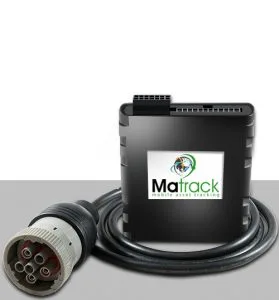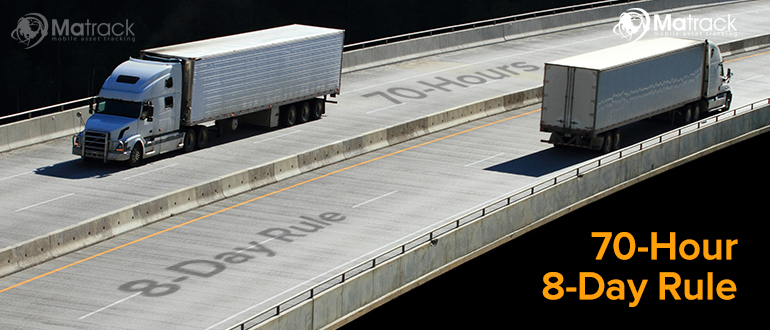Key Takeaways:
- The DOT 70-hour rule limits drivers to 70 hours of work in 8 days, requiring rest to reset their hours.
- Electronic Logging Devices (ELDs) simplify compliance by tracking hours and preventing violations.
- Violating the rule can lead to fines, license suspensions, and legal issues for drivers and carriers.
- Matrack ELD helps automate compliance, saving time and ensuring safety with real-time alerts and easy installation.
What Is the DOT 70-Hour Rule?
The DOT 70-hour rule limits the hours commercial drivers can work to 70 hours in any rolling 8-day period. This regulation is part of the Hours of Service (HOS) rules set by the FMCSA to reduce driver fatigue.
Drivers with a 7-day work schedule are limited to 60 hours over 7 consecutive days. After reaching these limits, drivers must take a break long enough to reset their hours before resuming work.
How the 70-Hour Rule Works
Rolling 8-Day Period
The 70-hour limit works on a rolling basis, meaning the hours worked over the last 8 days are always counted. For example, if a driver starts their week on Monday, their hours from the previous 7 days are used to see if they are still under the 70-hour limit.
Here’s how it might look:
- Monday: 10 hours worked
- Tuesday: 12 hours worked (total: 22 hours)
- Wednesday: 9 hours worked (total: 31 hours)
- Thursday: 11 hours worked (total: 42 hours)
- Friday: 8 hours worked (total: 50 hours)
- Saturday: 10 hours worked (total: 60 hours)
- Sunday: 10 hours worked (total: 70 hours)
By Monday, the driver is at 70 hours and can’t work again until they take a proper rest.
On-Duty Hours
On-duty hours include all the time a driver spends working, not just driving. This means it covers:
- Driving time
- Loading and unloading
- Waiting during loading or unloading
- Vehicle inspections
- Maintenance
- Any work done for the carrier
Everything a driver does on the clock adds up toward the 70-hour total, so keeping accurate records is critical.
Rest and the 34-Hour Reset
To reset the 70-hour clock, a driver must take at least 34 hours off in a row. This break, called a “34-hour reset,” clears the hours from the previous 8 days and lets the driver start fresh.
Drivers often plan their resets for weekends or downtime between trips to make the most of their rest period.
Why Is the 70-Hour Rule Important?
The 70-hour rule helps keep drivers safe, protects their health, and improves how fleets operate. It ensures drivers get enough rest and prevents accidents caused by fatigue.
Keeps Roads Safe
Tired drivers are more likely to cause accidents because they react slower and make bad decisions. The 70-hour rule lowers this risk by making sure drivers take regular breaks.
Protects Drivers’ Health
Driving too much without rest can harm a driver’s health, causing stress, high blood pressure, and other problems. The rule helps drivers maintain a better balance between work and rest.
Helps Fleets Work Better
Following the rule helps carriers avoid fines and delays from violations. Rested drivers also work more efficiently and make fewer mistakes, which benefits the whole fleet.
Compliance and Tracking the 70-Hour Rule
Role of ELDs
ELDs automatically track driving and work hours, making logs accurate and secure. They also alert drivers when they’re close to reaching their limit.
Driver Responsibility
Drivers need to know how to track their hours over 8 days. Checking logs daily and planning breaks can prevent going over the limit.
Carrier Responsibility
Fleet managers must train drivers on the rule and check their logs regularly. They also need to schedule routes and breaks to follow the 70-hour limit.
Penalties for Violating 70-hour rule
- For Drivers: They may face fines and lose their Commercial Driver’s License (CDL) temporarily if caught during an inspection or audit.
- For Carriers: Companies can be fined and lose their safety rating if they allow drivers to break the HOS limits.
- Increased Risk: If an accident happens and fatigue is a factor, both the driver and carrier could face legal consequences.
Best Practices for Compliance
Use ELDs
Use Electronic Logging Devices (ELDs) to track hours automatically and get alerts about nearing limits. ELDs make it easier to stay accurate and avoid accidental violations.
Plan Ahead
Create schedules that account for delays, loading times, and rest breaks. Planning ahead helps drivers avoid rushing or exceeding their hours.
Prioritize Rest
Ensure drivers take regular breaks and include 34-hour resets in trip plans. Proper rest prevents fatigue and keeps drivers safe on the road.
Train Drivers
Provide training on the 70-hour rule, showing drivers how to track hours and reset properly. A clear understanding of the rules helps drivers stay compliant.
Monitor Logs
Regularly review logs to catch potential issues early. This helps prevent violations and ensures smoother operations for the entire fleet.
Difference Between Property Carrying Vehicle And Passenger Carrying Vehicle
Do you know the 70-hour 8-day rule applies differently to different carriers? Yes, the maximum number of hours a property-carrying vehicle driver can drive is different from the number of passenger-carrying drivers. Refer to the table below to understand the difference between them.
| Property-Carrying Drivers | Passenger-carrying Drivers |
| 11-Hour Driving LimitMaximum 11 hours to drive time after 10 consecutive hours off duty. | 10-Hour Driving Limit Maximum 10 hours of drive time after 8 consecutive hours off duty. |
| 14-Hour LimitDrivers can only work for 14th consecutive hours after coming on duty, following 10 consecutive hours off duty. | 15-Hour Limit Drivers can only work 15 hours, following 8 consecutive hours off duty. |
| 30-Minute Driving BreakDrivers must take a 30-minute non-driving period consecutive break when they have driven for a period of 8 cumulative hours. | No preference |
| 60/70-Hour LimitMay not drive after 60/70 hours on duty in 7/8 consecutive days. A driver can restart the 7/8 consecutive day period only after taking 34 or more consecutive hours off duty. | 60/70-Hour LimitSame as Property-Carrying Drivers but no reference for restart |
| Sleeper Berth ProvisionDrivers, as per the sleep berth provision, must take eight hours of consecutive rest in the sleeper berth and two hours in either sleeper berth, off duty, or a combination of both. Note: The sleeper berth pairings MUST add up to at least 10 hours. | Sleeper Berth ProvisionDrivers using a sleeper berth must take at least 8 hours in the sleeper berth, and split the sleeper berth time into two periods provided neither is less than 2 hours. Note: The sleeper berth pairings MUST add up to at least 8 hours. |
| Adverse Driving ConditionsDrivers can extend the 11-hour maximum driving limit and 14-hour driving window by up to 2 hours in adverse driving conditions. | Adverse Driving ConditionsDrivers can extend the 10-hour maximum driving time and 15-hour on-duty limit by up to 2 hours in adverse driving conditions. |
Get Matrack ELD to Avoid Penalties

Matrack’s ELD helps drivers follow the DOT 70-hour rule by automatically tracking Hours of Service (HOS) and sending real-time alerts to avoid violations. It ensures smooth compliance and keeps operations safe.
The device is easy to install and works with any vehicle. Its dashboard generates HOS logs, IFTA reports, and other compliance documents instantly, saving time and avoiding errors.
Conclusion
The DOT 70-hour rule helps keep roads safe by limiting driver work hours and preventing fatigue. Understanding the rule and following it, including using the 34-hour reset, ensures compliance and reduces risks.





